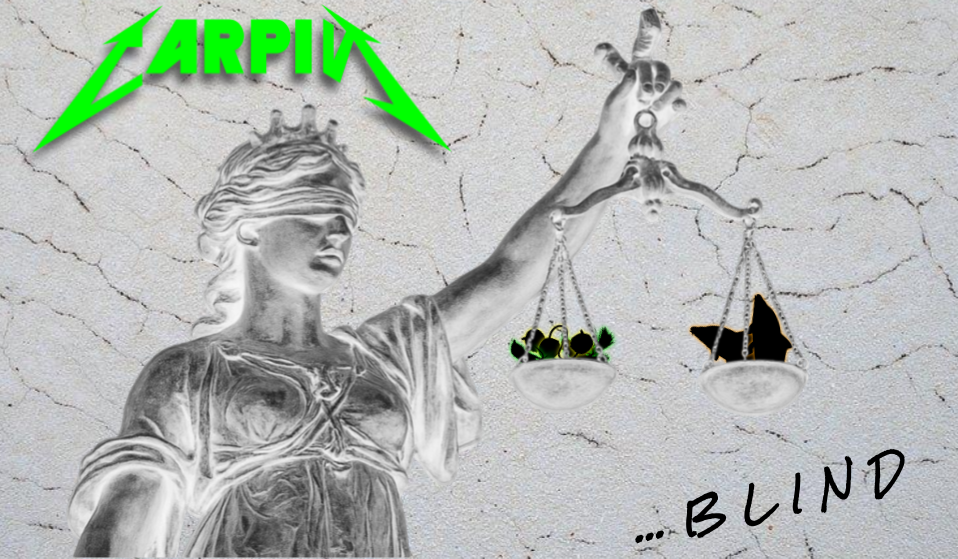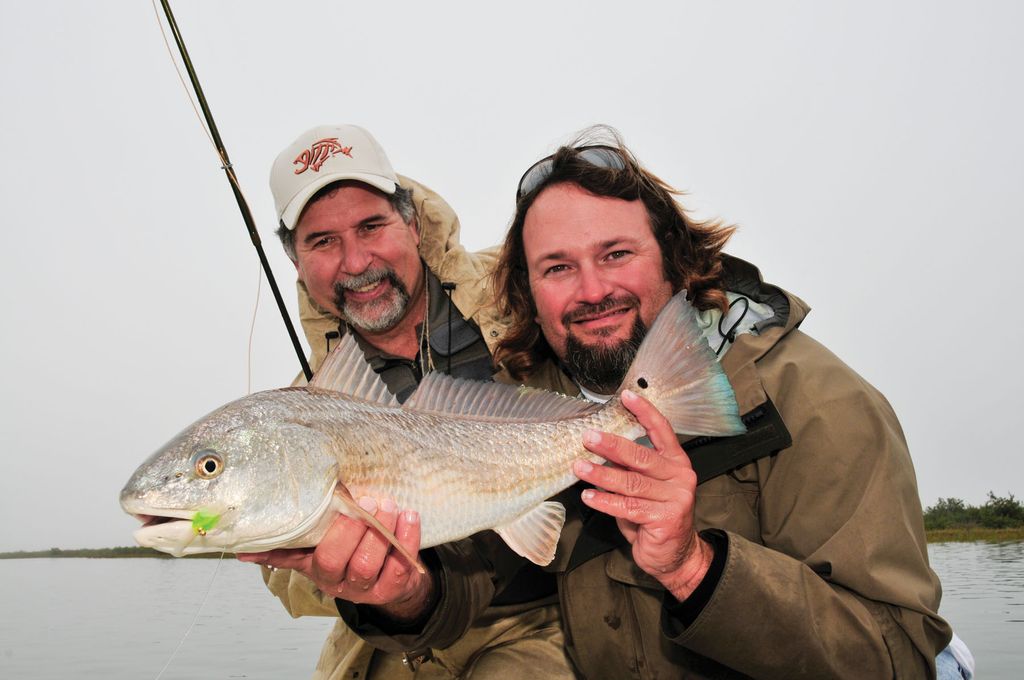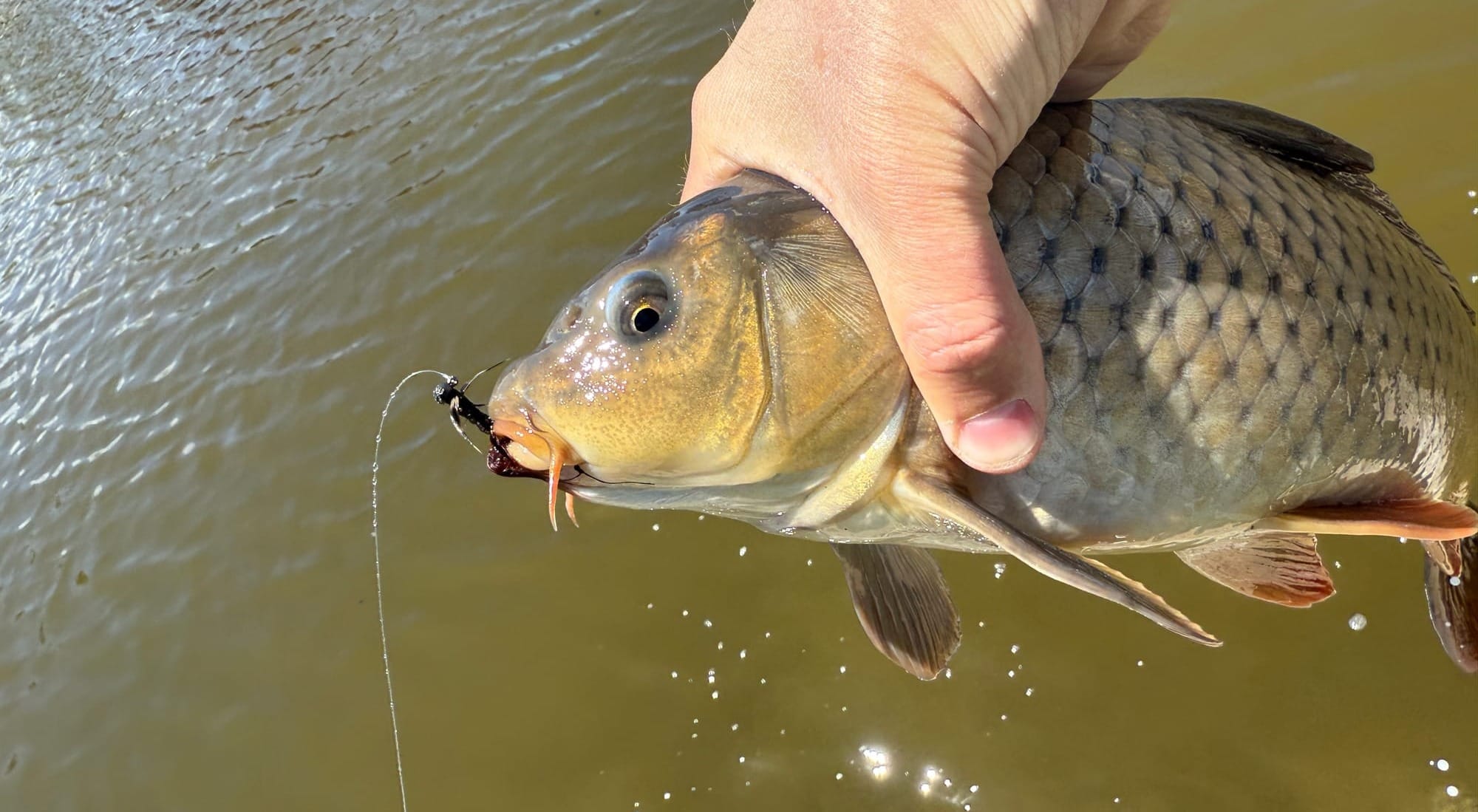Blind Casting for Carp
What is the best approach when water is too murky, or you can't see any fish? Chances are slim, but never hopeless...

June 2025
When I settled on my favorite neighborhood carpin' hole, I didn't realize how often I'd be tempted to check in. Lunch breaks, afternoon lulls, or the backend of coffee runs, each an adequate excuse to stop by. Usually the appeal of carpin' on the fly is the visual elements of sight-casting, dragging and dropping flies, and watching the fish react for a take. Still, as with anything in fishing, some days are just worse than others.
What happens when water is too murky, or you can't see any fish? Too many times I'd follow my usual game trail around the pond for a couple laps, and if I couldn't see anybody, I'd shrug my shoulders and move on. I know there are plenty of pictures in tackles shops with carp caught on shiny lures, but my wild and aimless casting always left me empty-handed.
Two things changed my outlook. First, I wandered across an article about blind casting for redfish in the Gulf of Mexico under compromised conditions. Redfish are another species that's mostly sight-fished, much like carp. The article egged me on, "why [are] so many fly-fishermen afraid to pick up a fly rod and cast blind?" The author was right, what's the worst that could happen?

Too often, guides, shops, and experts share advice that gets twisted into a rigid doctrine of practices. For carp, if you can't see them you can't catch them, full stop. At least that's the road-block I put in my own way.
The next outlook changer was less subtle. Not long after finding this redfish article, I noticed carp corralling baitfish in shallow water under a late afternoon sun, marked by unmistakable charges through nervous water. Casting my chartreuse headstand through the mess, line suddenly ripped off the reel screaming towards the middle of the lake before going slack. Maybe some carp are more willing to chase flies than previously expected.
Fast forward, after a couple seasons of mixing in some blind casting around various Front Range lakes, I've started to settle on when it works. Blind casting for carp is no guarantee, but there’s a time and a place. The time and place: desperation. Regardless, here's my notes for improving success if forced to blind cast for lake/pond carp.
1) Exhaust all other options
Drag-and-drop is the method with the best track record of success for catching carp. But if water is turbid, wind is really bad, you can’t try other venues, or carp profiles aren't visible in the water, its time to strip some streamers.
2) Need Signs
You still want to see signs of carp activity, so look for jumping fish near shore, or signs of mudding fish. You may know where carp hang out based on previous encounters, use this information to guide your casting. Spring is a better time for blind casting since carp are more aggressive, shallow, and willing to jump and give themselves away. I've had success stripping woolly buggers through clouds of mudding carp with aggressive takes as the result. A note on mudding fish: carp muds are usually only slightly darker than the surrounding water. If you see really dark, concentrated puffs of silt, it’s usually from the tail flick of a spooked fish.

Temperature is always important. Too cold, doubt it’ll work. On the other hand, warmer water means you may try stripping your flies faster.
3) Fly Choice
Keep it really simple. I usually fish a jigged woolly bugger on a slow consistent strip with several second pauses between retrieves. If you see more predatory behavior, fish a bright fly and strip more like a baitfish fleeing. Surprisingly, that's worked in the past with the chartreuse headstand. Kreelex are a surprising entry with a track record, but I don't usually keep that kind of flashy streamer in my carp box for my current waters.

Dry flies also make for easy blind casting. If you see sporadic cloopers (carp eating at the surface), even better! Fish dries with ample patience. Grease an egg pattern or stimulator. If you live near brood cicada, buckle up!
4) Indicators and Droppers
Despite all my efforts with indicators, and I actually enjoy watching indicators, I’ve yet to entice a carp. Things might be different during midge or damsel hatches but in my lakes, no dice. I think carp really prefer the dropping motion of well presented flies instead of a static suspended offering, but carp live in varied places and are constantly surprising. I still carry around those light foam stick on indicators just in case, they're sensitive and weight almost nothing. Instead of an indicator, dry droppers (especially for cloopers) may be the solution. I landed my largest grass carp on an egg suspended below a grasshopper pattern, casting into a pod. The trick is setting the dropper distance correct.
5) Line Considerations
If you see a faint tail, or dorsal, you won’t after a couple casts landing over their back. So any subtle signs of fish nearby require a more delicate approach. No signs of fish? Blast away. As a stealthier alternative to traditional colored floating lines, I’ve started testing clear floating lines. My thinking here is that the shadow of the line will be less noticeable and therefore less likely to alert fish to my shenanigans, which is especially helpful if you're casting with less discretion. At the very least, they don’t hurt your chances.

6) Location x 3
Some lakes are just going to be better than others for blind tactics. Smaller ponds, and shallow silty areas are ideal. If you know there are no other fish around besides carp, your odds of hooking a carp go way up! If there are bass or other species sharing the space, bycatch might stand between you and your desired target.
7) Behavior
Usually the less pressured the water, the more bold the carp, the more likely you’ll get away with blind casting.… but if you see a carp feeding within casting distance, drag and drop is still king.
8) Hang
Often carp will hang out under muck lines, or other places where surface debris collect. Plus, these are also good places to find too. But even if you don’t see fish feeding, a heavy enough fly hung underneath the scummy surface could get attention for any fish chilling out in the shade. Best bets are to hang a fly just below the scum, or right off the bottom. Hold your line tight to watch for strikes, or wait for a tap.


